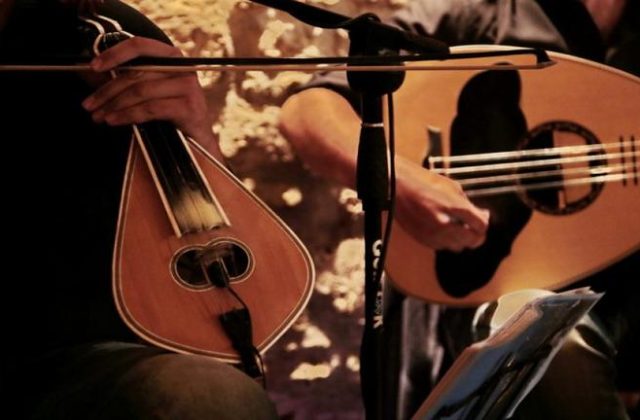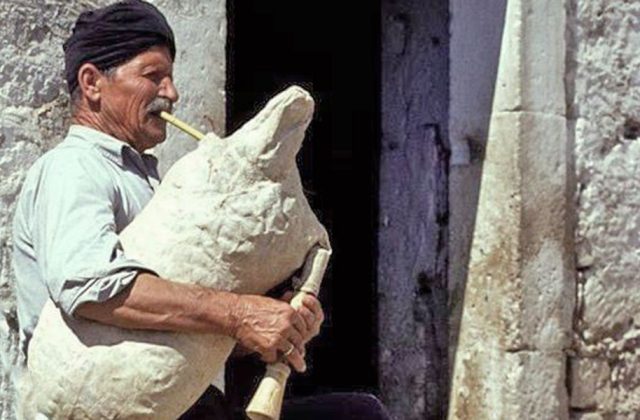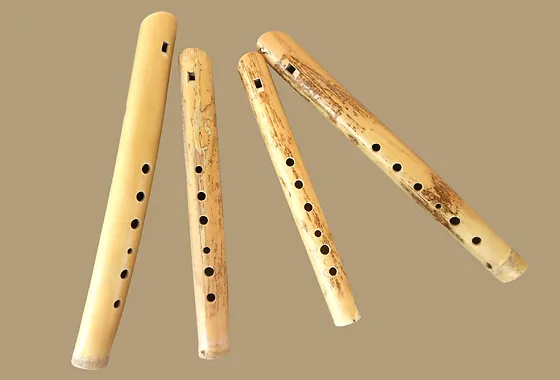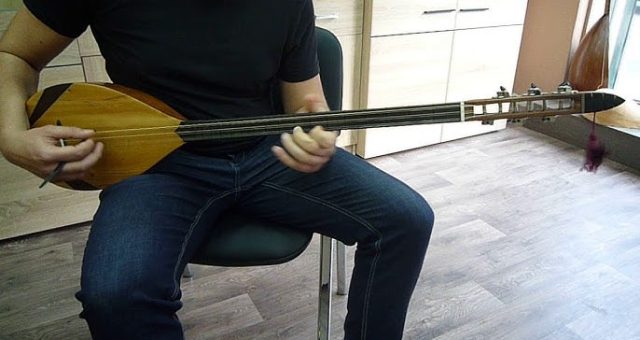Musical instruments of Crete
Cretan musical instruments heard in the recordings of traditional Cretan music include the pear-shaped Cretan lyra, the mandolin, the lute, the traditional violin, the askomandoura, the thiamboli, the bulgari and the viololyra.

Cretan Lyra
Considered to be the most pre-eminent Cretan musical instrument. It belongs to the family of string instruments played with a bow (bowed instruments). It has three strings which, in order to produce the sound, are plucked by the performer’s fingernails — one of the many differences between the Cretan and other lyras. In the past, the strings were made of gut and bells called ‘gerakokoudouna’ were hung on the bow. The archive contains a recording of a lyra with gut strings, played by Kostas Mountakis.

Viololyra
Considered to be the most pre-eminent Cretan musical instrument. It belongs to the family of string instruments played with a bow (bowed instruments). It has three strings which, in order to produce the sound, are plucked by the performer’s fingernails — one of the many differences between the Cretan and other lyras. In the past, the strings were made of gut and bells called ‘gerakokoudouna’ were hung on the bow. The archive contains a recording of a lyra with gut strings, played by Kostas Mountakis.

Mandolin
The mandolin also belongs to the category of plucked chordophones and is played using a pick. An instrument of Italian origin, in Greece the mandolin is found on Crete and in the Ionian Islands, a testament to the Venetian influence on the music of these regions. It has 4 pairs of strings and fixed frets. It was not widely used on Crete in the past. More recently, it began appearing in villages in central and eastern Crete, where it was used to accompany the violin and the lyra, before gradually evolving into more of a soloist instrument.

Lute
It belongs to the category of plucked chordophones, i.e. instruments played with fingers or some kind of pick. This particular instrument is encountered in Renaissance Europe, originating from the Arabic lute. The modern Greek lute has immovable metal frets, four pairs of metal strings and is played with a plastic pick. Nowadays, the Cretan lute, which is tuned differently from island and mainland lutes, accompanies other traditional Cretan musical instruments, such as the lyra or violin. In the past, however, it had moving frets (berdelidiko), enabling musicians in western Crete (Chania-Kissamos) to use it even as a solo instrument and allowing them to cover even major festivals using just that instrument.

Violin
This instrument is considered to be Italian in origin and its use in traditional music of Crete is a testament to the influence of Italy. Like the Cretan lyra, it belongs to the family of bowed string instruments. In Greece, the traditional violin can be found in various regions, while on Crete it is preferred over the lyra in eastern and western Crete.

Askomandoura
This instrument belongs to the bagpipe family, i.e. aerophone instruments mainly consisting of a bag fitted with a mouthpiece connected to a bag made of animal, goat or sheep skin. Bagpipes first appeared in the East about 3,000 years ago. The use of the instrument on Crete dates back to the 15th century AD. The Cretan askomandoura consists of a wooden mandoura with 5 holes.

Thiamboli
This is considered to be primarily a pastoral instrument. It belongs to the wooden aerophone family and is related to the recorded and has different names across the various regions of Crete, e.g., it is called hambioli and bambioli in western Crete, thiamboli in the Selino province, peirohamboulo in Krousonas (Heraklion), and glossohamboulo and sphyrohamboulo in Voriza (Heraklion). While usually made of reed or wood, on Crete it is made from animal bone and is hand-carved by the player themselves. It consists of a tube that is open-ended at its base. It is played alone or accompanied by a percussion instrument, such as the daoulaki on Crete.

Bulgari
The bulgari belongs to the category of plucked chordophones and, more specifically, the tambouras family, whose ‘ancestor’ was the trichordo [three stringed] (which, in Ancient Greece, was called pandura). The bulgari has a curved sound box and is pear-shaped, while its neck is long and thin. It has three double strings and movable frets. The saddle is movable and the strings are tied to the tailpiece of the instrument. It is a typical musical instrument of Crete, which is used mainly in tabachaniotika, i.e. the urban Cretan popular songs which combine elements of the local tradition, traditional Asia Minor and rebetiko.

Daoulaki (toumbi)
On the islands, the small daouli (drum) that accompanies the tsambouna or the violin is called toumbi (on Crete) or daoulaki. This is a smaller type of daouli played with two identical sticks, the toumboxyla, which the performer strikes against a leather surface. The differences between the daouli and the smaller daoulaki concern the size, sticks and playing method.

